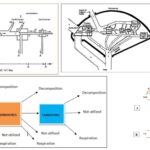IGCSE Biology 97 Views 1 Answers
Sourav PanLv 9November 14, 2024
Describe and compare the structure of a plant cell with an animal cell, limited to: cell wall, cell membrane, nucleus, cytoplasm, chloroplasts, ribosomes, mitochondria, vacuoles
Describe and compare the structure of a plant cell with an animal cell, limited to: cell wall, cell membrane, nucleus, cytoplasm, chloroplasts, ribosomes, mitochondria, vacuoles
Please login to save the post
Please login to submit an answer.
Sourav PanLv 9May 15, 2025
The comparison of plant and animal cells reveals significant differences and similarities in their structures. Here’s a detailed description of the main features used to differentiate between plant and animal cells, focusing on specific components:
Comparison of Plant Cells and Animal Cells
| Feature | Plant Cells | Animal Cells |
|---|---|---|
| Cell Wall | Present; made of cellulose, providing rigidity and structural support. It protects the cell and maintains its shape. | Absent; animal cells only have a flexible cell membrane that allows for varied shapes and movement. |
| Cell Membrane | Present; a semi-permeable membrane that controls the entry and exit of substances. It is located inside the cell wall. | Present; a semi-permeable membrane that surrounds the cell, regulating the movement of substances in and out. |
| Nucleus | Present; contains genetic material (DNA) enclosed by a nuclear membrane, similar to animal cells. | Present; contains genetic material (DNA) enclosed by a nuclear membrane, similar to plant cells. |
| Cytoplasm | Present; the gel-like substance where organelles are suspended and where metabolic processes occur. | Present; similar to plant cells, it contains organelles and is the site for metabolic activities. |
| Chloroplasts | Present; contain chlorophyll for photosynthesis, allowing plants to convert light energy into chemical energy. | Absent; animal cells do not perform photosynthesis and therefore lack chloroplasts. |
| Ribosomes | Present; involved in protein synthesis, found freely in the cytoplasm or attached to the endoplasmic reticulum (ER). | Present; similar function as in plant cells, involved in protein synthesis, found freely or on the ER. |
| Mitochondria | Present; known as the powerhouse of the cell, responsible for energy production through cellular respiration. | Present; also known as the powerhouse of the cell, performing similar functions as in plant cells. |
| Vacuoles | Typically large central vacuole present; stores water, nutrients, and waste products, contributing to turgor pressure for structural support. | Smaller vacuoles may be present but are not central or as prominent as in plant cells; primarily involved in storage and transport. |
Detailed Explanation of Key Features
- Cell Wall:
- Plant Cells: The cell wall is a rigid structure composed mainly of cellulose that provides support and protection.
- Animal Cells: Lack a cell wall, which allows for more flexibility but makes them more susceptible to changes in their environment.
- Cell Membrane:
- Both plant and animal cells possess a cell membrane that regulates what enters and exits the cell.
- Nucleus:
- Both types of cells have a nucleus that houses DNA and controls cellular activities.
- Cytoplasm:
- The cytoplasm is present in both types of cells, serving as the medium for biochemical reactions.
- Chloroplasts:
- Unique to plant cells, chloroplasts enable photosynthesis by capturing light energy. Animal cells do not have chloroplasts since they do not perform photosynthesis.
- Ribosomes:
- Ribosomes are present in both cell types for protein synthesis but are structurally similar.
- Mitochondria:
- Mitochondria are present in both plant and animal cells, providing energy through cellular respiration.
- Vacuoles:
- Plant cells typically contain one large central vacuole that maintains turgor pressure, while animal cells have smaller vacuoles that perform various storage functions.
0
0 likes
- Share on Facebook
- Share on Twitter
- Share on LinkedIn
0 found this helpful out of 0 votes
Helpful: 0%
Helpful: 0%
Was this page helpful?




